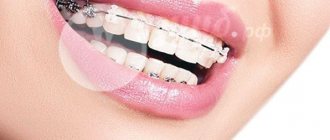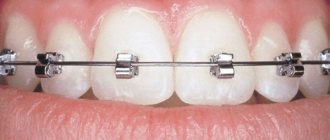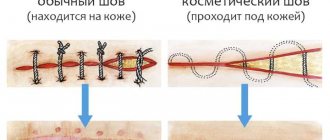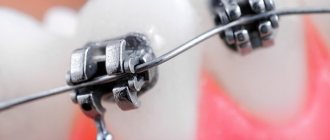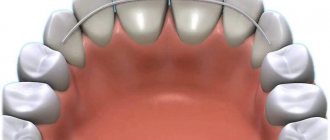Metal braces are used to straighten teeth and correct bites. This is necessary to ensure that the smile is beautiful, the chewing load on each tooth is evenly distributed, and the gastrointestinal tract remains healthy. Metal braces make it possible to correct uneven teeth, remove gaps between teeth, put teeth that have been pushed forward or shifted back into place, and rotate teeth that are incorrectly rotated relative to their own axis. The cost of installing metal braces is lower than ceramic ones, since they are not as aesthetically pleasing - they are clearly visible on the teeth.
Metal braces: pros and cons
Classic metal braces have been used in dentistry for over a hundred years. It is logical to assume that such a significant period indicates many advantages. Let's take a closer look at them.
- Metal braces are reliable and durable, so they are suitable for any clinical cases. They will help correct the most complex malocclusions and crowded teeth.
- The treatment period with metal braces will be shorter than with other systems (this is an important difference between ceramic braces and metal braces). Those patients who want to correct the defect as quickly as possible should choose them.
- Metal braces on teeth are more difficult to damage from hard food, and they are not stained by tea, coffee, wine and carbonated drinks with dyes.
- Finally, this is the most affordable type of orthodontic appliance. Getting metal braces cheaply is not difficult at all.
The disadvantages include the way metal braces look on your teeth. And although manufacturers are constantly improving the appearance of the structure - making smaller clasps and offering self-ligating metal braces without rubber bands or wires, the aesthetics of such systems still leave much to be desired. There is also the possibility of an allergy to the metal of the braces. Despite the use of only safe alloys - titanium, stainless steel, nickel, locks can cause an individual reaction. Before installation, patients prone to allergies must find out what metal the braces of the chosen brand are made of.
Materials for production
In this design, the raw materials that were used in the manufacture of the structure are also important, since each material has its own properties and characteristics. The most common bracket systems are those consisting of materials such as:
- Plastic. A system made from this material is the most affordable, but is used only if the treatment period is short-term. This system is quite impractical because the plastic, absorbing dyes, changes color very quickly. And also the structure of this material is very rough, which leads to the accumulation of a large number of bacteria on its surface.
- Ceramics. This is a special type of ceramic that is used only in dentistry. It has a large margin of safety (only metal is stronger). Its surface is very similar to natural tooth enamel and has a matte surface, which allows you to make braces almost invisible.
- Metal. The arc and fastenings are made from this material. Only medical alloys that do not cause allergic reactions and are not rejected by the body are used for these purposes. They are also resistant to external influences.
- Sapphire. In dentistry, only artificially grown sapphires are used, namely their single crystals. This material transmits light well, which allows it to remain invisible on teeth with fairly light enamel. This design is more fragile in comparison with the others, but still copes with its main functions perfectly.
Orthodontics has advanced quite a lot in the 21st century, so structures are made from the most comfortable and safe materials, and the effect of wearing braces before and after can exceed all expectations, but for this you need to be patient and also follow all the instructions of your doctor.
Types of metal braces
Based on the place of attachment to the teeth, braces are divided into vestibular and lingual. Another classification is based on the presence or absence of ligatures - auxiliary elements with which the braces are connected to the arch. Ligatures can be in the form of rubber bands or thin wires. There are also mini braces.
- Vestibular structures
are installed on the outer part of the teeth. These are ordinary metal braces that we are all familiar with. Such braces are more universal, correct a defect faster, do not distort diction and require less time to get used to. On the other hand, vestibular systems are visible on the teeth and can damage soft tissue. - Lingual metal braces
are installed on the inside of the teeth, so the brackets are not visible to others. This is an ideal solution for those who want to hide the fact of orthodontic treatment, for example, for public people. True, you will have to prepare for a longer period of bite correction, take longer to get used to the design, and also part with a much more significant amount. - Metal ligature braces
are visually more “heavy” and require frequent (every 3-4 weeks) visits to the orthodontist for correction, since the ligatures quickly stretch. However, some doctors consider such systems more suitable for difficult cases, and the cost of their installation is lower. - Metal non-ligature braces
Instead of ligatures, the systems use special latches or clamps. They do not block the arc, making the friction force minimal, which has a positive effect on comfort and treatment time. Patients with a metal self-ligating brace system can come for corrections half as often, and the procedure itself will last a matter of minutes. However, ligature-free braces are more expensive. - Non-ligature
For more comfortable and aesthetic treatment in orthodontics, special mini-designs have been developed. Their size is 20-30% smaller than standard braces, while the timing and effectiveness of treatment remain the same. This is a more aesthetic alternative to classic metal braces, which also does not require large expenses.
Indications and contraindications for installation
There are many indications for installing braces, but the main one is the alignment of the dentition, the correction of malocclusion (disturbance in the alignment of the upper and lower rows of teeth). Correct bite implies complete coverage of the lower incisors by the canines, and the chewing surfaces of the back teeth should touch the part that is closer to the inside of the oral cavity. Otherwise, there are indications for installing braces. This system is also recommended for the following jaw anomalies:
- Open bite. The dentition does not close in the lateral or anterior area. Installation of braces is one of the stages of treatment.
- Facial asymmetry. This pathology is most often caused by the hypertrophied development of one of the jaws, but the second jaw remains underdeveloped.
- Crossbite. It appears when one of the jaws is underdeveloped and slightly shifted to the side, however, both the lower and upper rows of the dental arch are not located exactly above each other.
- Crowded teeth. The teeth are rotated around their axis.
- Deep bite. The anterior part of the upper jaw excessively overlaps the lower jaw.
- Diastema and trema. Too much space between teeth.
- Distal bite. Violation of the position of the jaw (the upper one protrudes significantly forward).
- Medial bite. The lower jaw protrudes strongly forward. Most often, orthodontic appliances are used as the only treatment option.
The bite and development of the jaws are checked by a dentist whose specialty is orthodontics. It is he who prescribes treatment if necessary, and also installs the system in accordance with the type of bite.
Despite the fact that this is a fairly simple system that allows you to solve such global problems as correcting the bite, it has a number of contraindications; if they exist, wearing the structure is not recommended or is significantly limited. There is a conditional division of contraindications, which are relative and absolute.
16 photos in the style of what was then:
Relative ones are a temporary reason for refusing to use a system such as braces (the results will also be positive), after which the structure can be used. These reasons include:
- various neoplasms in the oral cavity;
- periodontal disease or periodontitis in the acute stage;
- the presence of metal implants in the oral cavity;
- bruxism (unconscious grinding of teeth during sleep);
- insufficient oral hygiene;
- allergic reactions to the material used to make braces;
- diseases of bone tissue with damage to the temporomandibular joint.
Absolute contraindications include those causes that cannot be eliminated. Therefore, to restore the correct bite position, orthodontists resort to other treatment methods. A contraindication to installing braces may be the presence of diseases such as:
- tuberculosis;
- diabetes;
- HIV;
- blood diseases;
- autoimmune diseases;
- oncology;
- mental illness;
- absence of a large number of teeth.
Those who are about to install a braces system are certainly interested in knowing what braces look like. However, this design is quite complex, so it is better to familiarize yourself with it at an appointment with a specialist or in a picture.
Metal braces from different manufacturers
- Damon Q metal braces
are perhaps the most popular on the market due to their patented design and locking system. The advantages of the Damon brand are reliability and reduced treatment time.
- Victory metal braces
from 3M Unitek are considered one of the most attractive metal solutions. They are distinguished by the anatomical shape of the locks and a special surface that facilitates installation. In addition, 3M metal braces belong to the budget category. - Metal braces “Pilot”
are a domestic development that combines an affordable price and quite a good level of efficiency. There are no innovative technologies here, but the solution copes with its main task. - Metal Marquis braces
from Ortho Technology are also in demand among doctors and patients. They are easy to use and especially hygienic: the clasps are precisely adjusted to the teeth and have a low profile, so they are comfortable to wear, and food residues will practically not get stuck between the elements of the system. At the same time, Marquis metal braces allow you to replace arches in the shortest possible time. - American Orthodontics Empower metal braces
are the flagship products in the orthodontic construction market. They are effective and reliable, as well as aesthetically pleasing due to the small size of the locks. However, the cost of their installation will be higher than many analogues. - Mini Master metal braces
from American Orthodontics are miniature in size (25% smaller than other systems). They are “shrunk” not only in width, but also in thickness, which eliminates injury to soft tissues. Mini Master also gives you the opportunity to wear colored metal braces of your favorite shade.
What is a prescription for braces?
Why do they have braces? To move teeth into a physiological position and form a correct bite. The attending physician who develops the correction program is responsible for choosing the directions of movement. It is implemented thanks to the arch and the so-called bracket prescription, in which several of its individual parameters are encoded.
All teeth differ not only in size, but also in anatomical shape. And in order for them to line up in an even row of teeth, the shape of which is determined by the orthodontic arch, three parameters are laid down in the prescriptions:
- the thickness of the bracket corresponding to the thickness of the tooth for which it is responsible for moving;
- angulation of the groove, which sets the inclination of the lock relative to the vertical;
- groove torque, responsible for the inclination of the front tooth surface relative to the vertical.
Braces unique for each tooth began to be used not so long ago. A technique that greatly simplified the work of orthodontists was implemented in the 1980s. It was called the “straight orthodontic arch”, as it made it possible to avoid its numerous fractures.
Which metal braces are better?
You can choose one or another type of braces only after diagnosis, and also based on the financial capabilities of the patient. A metal ligature braces system would be the best choice if you need to save money, while metal self-ligating braces are suitable for busy people who are short on time. In addition, it is much easier to care for a structure without ligatures.
As for lingual systems, due to their cost and complexity of installation, they are not yet very popular in Russia, and finding a good doctor who specializes in such designs will not be easy. Therefore, based on a combination of factors, vestibular metal self-adjusting braces can be called the optimal solution.
How to install braces: diagnosis and treatment plan
Diagnostics allows you to identify contraindications, assess the condition of teeth and gums, take pictures and develop a further treatment plan. After the diagnostic examination, approximately a week passes, during which the doctor analyzes the material and draws up a plan for installing orthodontic structures. There may be several such plans and they differ in the method of fixing the braces or their type. The patient has the right to choose one of the proposed treatment options. Then the next stage begins - preparing the oral cavity for installation of the structure. Its duration is determined by the condition of the teeth and gums.
Installation of metal braces
In order to get metal braces, you need to go through three main stages.
- Diagnostic.
This includes: consultation with an orthodontist, medical history, radiography, orthopantomography, photographs of the patient from different angles, drawing up a treatment plan and choosing the appropriate brace system. - Sanitation of the oral cavity.
Treatment of caries and other diseases, elimination of foci of inflammation, if necessary, extraction of teeth or prosthetics, removal of hard deposits and plaque, strengthening of enamel. - Direct installation of a metal bracket system.
The last stage lasts no more than two hours. The doctor prepares the surface of the teeth, glues a separate lock-bracket to each tooth one by one, and fixes the adhesive solution with an ultraviolet lamp. If the locks are installed using the indirect method, that is, all at once, the procedure time is halved. He then connects the clasps to the archwire using ligatures or built-in fasteners. At the end, additional elements are installed - rings, cheek locks, hooks for elastic rods, springs, and so on.
In rare cases, metal braces are placed on one jaw. This is possible with slight curvature of the teeth, which does not affect the bite in any way.
What job does an orthodontic arch do?
A flexible arch with shape memory is initially given the shape of an ideal dentition. After it is fixed in the grooves of the braces, it changes shape and, trying to take its original form, creates a traction force that returns the teeth to the correct positions calculated in advance.
In order for the arc to fulfill its task, it is made of durable and reliable alloys:
- high-quality dental steel Stainless steel, SS;
- titanium-molybdenum TMA, proposed by the North American company ORMCO, a well-known manufacturer of aesthetic braces Damon and sapphire Inspire Ice;
- superelastic nickel-titanium NiTi;
- cobalt-chromium-nickel Elgiloy.
Arches differ in terms of rigidity and elasticity, diameters and sections and are selected depending on the severity of the anomaly and the stage of treatment. For the patient’s comfort, the doctor tries to develop the traction force gradually. Therefore, first he threads a softly working thin round arc into the grooves, and then gradually activates the treatment, successively increasing the diameters. At the last stage, an arc of square or rectangular cross-section can be used, completely filling the grooves.
To give the product a more aesthetic appearance, a coating is applied to the metal alloy that matches the natural shade of the enamel and the color of the locks. The arc can also be coated with gold to give it a more impressive look. The coating makes the arcs hypoallergenic, allowing them to be installed by patients with allergies to nickel and other alloying additives. In some cases, the patient may be offered arches made of noble gold or platinum.
How is treatment with metal braces performed?
Fixed orthodontic appliances apply constant pressure to the teeth, causing them to gradually move into the desired position. The arch plays a significant role in this process: at first it repeats the irregular shape of the teeth, but tends to return to its original position, thanks to which it smoothly corrects the bite. After each correction, the doctor changes the archwire to a thicker one to increase the pressure.
Let's look at why metal braces straighten teeth faster. The main quality of a metal system is its strength, and it does not really matter what metal is used in the braces. Due to the force of pressure, the teeth move faster and the treatment period is reduced. If the patient is faced with a choice between sapphire or metal braces, he must understand: although the sapphire design looks attractive, it will take a little longer to wear due to the fragility of the material.
So how long do you wear metal braces? Orthodontists call the average treatment period 1.5 - 2 years, but everything, of course, depends on the clinical case. The minimum period is 1 year for mild crowding of teeth, the maximum is about 3 years.
Duration of treatment
It is almost impossible to name the approximate time it will take to completely eliminate malocclusion without appropriate examinations, since each case is individual. It is influenced by many factors, the main of which is the severity of the pathology. And also the duration of treatment may depend on the age of the patient and the characteristics of his body.
In order to understand how the treatment period is calculated, it is important to know that the teeth, which are fixed in the sockets, are quite firmly surrounded by soft tissues that can change their properties under constant pressure (they become more pliable). The bracket system exerts constant pressure on each tooth in the opposite direction, thereby promoting its displacement.
The only thing that can be said is that the period required for the tissues surrounding the tooth to interact with the system is at least one and a half years. If the case is very simple, you can limit the period to six months. Whereas the longest treatment can last up to five years.
Expert opinion
Ravcheeva Yulia Anatolyevna
General dentist
Orthodontics not only helps to straighten teeth and make a beautiful smile, but also restores impaired functions such as chewing and speech, which is very important in everyday life.
Hygiene rules and nutritional features
An integral part of orthodontic treatment with braces is constant monitoring of the condition of the oral cavity. After installing the system, if you experience discomfort or pain from rubbing, you should immediately contact your orthodontist. He will correct the design, apply special food-grade wax to the areas of braces that injure the gums, and prescribe medications for the treatment of inflammatory processes in the oral mucosa.
It is very important to develop good eating habits:
- do not eat solid food;
- healthy vegetables and fruits - only grated or cut into pieces, but in no case whole;
- exclude everything crispy and sticky (crackers, toffee, chewing gum, caramel, etc.);
- avoid sweets and soda to protect tooth enamel;
- Avoid very hot and cold drinks—temperature changes can cause braces to come off your teeth;
Anyone who wears braces is recommended to brush their teeth every time after eating, most thoroughly before going to bed. It is necessary to use tools such as:
- orthodontic brushes (with a small compact head and a V-shaped recess in the middle) for high-quality and gentle cleansing;
- dental floss (preferably orthodontic);
- an irrigator that will help remove food debris, plaque, and also prevent bleeding by massaging the gums;
- brush-brush for cleaning locks and removing stuck food in braces;
- restorative mousses with minerals.
It is recommended to visit a hygienist for professional teeth cleaning approximately once 3 months.
Prices for braces in our clinic
The price of a braces system consists of several components:
- type of orthodontic structure
- material from which the braces are made (metal, ceramic, sapphire)
- manufacturing company
INTAN Implantation and Dentistry Centers offer an objective price/quality ratio for dental correction in St. Petersburg. Our policy is honest, low prices , which means you won’t find hidden fees or fine print in the contract.
In addition to the above factors that influence the final cost of orthodontic treatment, the price formation is influenced by the initial condition of the patient’s oral cavity, the need for preliminary preparation, and the frequency of correction during treatment.
You can consult a dentist about the details of installing a braces system, who will offer several options that are suitable specifically for your situation. To avoid problems, it is better to make the final choice together with your doctor.
What is the difference between ceramic braces and metal braces?
Many patients are interested in what is better - ceramic or metal braces. You need to understand that both types of systems cope well with their task, the only question is in the details.
When choosing ceramic or metal braces, you should decide on your priorities: aesthetics or treatment time? Ceramic systems are practically invisible on the teeth, and this makes the correction psychologically more comfortable. On the other hand, if it takes a year and a half to correct a moderate defect with metal braces, then with ceramic braces it will take about two years.
Lifestyle will help you understand which braces are better - ceramic or metal. Metal is much less capricious: it does not stain under the influence of red wine, tea and coffee, and is also not prone to chips and cracks.
Another popular question is whether it is possible to smoke with metal braces. If we do not take into account the harm from smoking as such, then it is really better for smokers to install a metal system, since ceramics can change color under the influence of resins.
Popular models
You can consider the features of brace systems in more detail using the example of popular models.
STB
Lingual, ligature, metal system. Corrects even serious malocclusions. Treatment lasts a little longer than with more expensive devices.
photo: STB bracket system
The braces are only 1.5 mm thick. This size is achieved by reducing the bracket. Fixation occurs at a close distance from the root. Orthodontists do not recommend installing such a system if the teeth are very crowded.
DamonQ
Self-ligating (ligature-free) bract system from Ormco. Represents the latest model of the Damon line. The locks are so small that they look like rhinestones. Each bracket is equipped with a small cap, which, when closed, forms a tube for attaching the arch.
photo: Daimon Q bracket system
The load due to which bone stimulation is carried out is not so great as to disrupt the blood supply to the periodontium. However, it is sufficient to effectively move teeth.
Victory
The peculiarity of the series is that the braces have a high adhesion force to the teeth.
photo: Victory bracket system
The base of the bracket consists of 80 cells that are woven into a network. It follows the anatomical structure of the crown , thereby ensuring the best fit to the enamel. The wings on the premolar are slightly spaced from the tooth and slightly expanded.
Alexander
Wings of such designs allow you to change the level of rotation (displacement). The alloys from which locks are made include chromium, iron, aluminum and copper.
photo: Alexander bracket system
Thanks to this, the orthodontic structure is highly durable and not subject to oxidation . Quick achievement of results is ensured by the peculiarities of load distribution.
In Ovation R
photo: In Ovation R bracket system
Unique metal design. Interactive wire latch reduces brace installation time. The base is made of triple mesh. The special spring properties of the arches speed up the treatment process.
Combined braces: metal and ceramic
To save on installing an aesthetic system, you can choose combined metal and ceramic braces. When a person smiles, the lower teeth are less visible, so to save money it is worth putting metal braces on the lower jaw and ceramic braces on the upper jaw. This is a worthy compromise between the cost of treatment and psychological comfort during it. Similarly, you can combine sapphire with metal.
Are there any contraindications
All restrictions can be divided into absolute and relative. The first assume certain pathological conditions in which installation of the device is impossible. Relative contraindications prohibit the fixation of the device only until they are eliminated. The absolute category includes the following phenomena and states:
- mental disorders,
- the absence of a significant number of teeth, in which it would be more advisable to immediately proceed to prosthetics,
- pathologies of the immune and endocrine systems, including diabetes - orthodontic treatment is associated with the risk of inflammation of the gums, namely the periodontal tissues, and this is dangerous not only due to tooth displacement, but also its complete loss1,
- bone diseases,
- pathologies of the heart and blood vessels,
- diseases of the hematopoietic system,
- tuberculosis,
- oncology,
- HIV, sexually transmitted diseases.
Experts in the field of orthodontics include periodontitis, periodontal disease, cysts, granulomas, and allergies to metals as relative prohibitions - just choose a model made of a different material.
Is it possible to get metal braces inexpensively?
Undoubtedly. Installing regular staples is the cheapest. However, the price of metal braces can vary. Designs with ligatures will cost the least - from 25,000 rubles, a metal non-ligature bracket system starts at 35,000 rubles. Of course, we are talking about vestibular structures, since the price list for lingual systems starts from 100,000 rubles. Ceramic braces with a metal groove will be an order of magnitude more expensive than a conventional system. You also need to keep in mind that metal braces for the upper jaw are more expensive than for the lower jaw. Such designs are the most affordable, and this is also the difference between metal and ceramic braces. The table below will help you navigate the cost of metal structures, as well as a call to a clinic where you can install braces in Moscow.
| Bracket systems | Price |
| Vestibular | from 50,000 rubles |
| Lingual | from 100,000 rubles |
| Mini | from 30,000 rubles |
| Ligature | from 25,000 rubles |
| Unligated | from 35,000 rubles |
How long to wait for the effect
Traditional staples are considered the fastest, especially when it comes to non-ligature models. The average treatment period is 1-1.5 years, but correction of minor curvatures may require only six months. If there is a complex defect, the orthodontic course can last up to 3 years. Even an orthodontist will not be able to announce the exact duration of treatment - first the patient is told the approximate duration, because during the correction it may turn out that it takes a little more time to achieve the desired result. Typically, the planned and actual period of wearing the device do not differ much from each other.
In addition, it should be taken into account that after the removal of the structure, a retention period begins - the patient is fixed with a retainer to consolidate the achieved effect. At the same time, the invisible wire structure can be fixed either for a limited period or not at all. It is fixed on the back side of the row, and it remains completely invisible to others and almost intangible to the patient himself.
Self-regulating braces design reviews
From my own experience, I can say that for the majority of patients, adaptation is quick and painless. After getting used to it, there are no problems with cleaning and eating. All patients are satisfied with the results of the treatment, except for those cases when people think that they overpaid for the design and it was not worth the money. Regarding this, I can say one thing: all designs have their place in modern orthodontics, and choosing a budget design is not always the worst option. At the LeaderStom clinic, our specialists will advise you on any issue on this or any other topic, and will also give you back a beautiful smile.
How are braces removed?
Dismantling of the structure is carried out in the dentist’s office and is carried out in several stages:
- using a special tool, the locks are unfastened;
- the arc exerting pressure is disconnected from the locks;
- each lock is removed using tweezers;
- Solvent removes remaining glue from the enamel.
To consolidate the results of treatment, the patient wears a plate for 2-3 weeks to straighten the teeth and protect them from stress. Immediately after removing braces, ultrasonic cleaning or whitening can be performed.
How to install braces: sanitation of the oral cavity
After installing braces, the procedure for brushing your teeth becomes noticeably more complicated and the risk of developing caries increases. To reduce it to a minimum, you need to eliminate all carious cavities. The main task of the dentist is to identify hidden foci of pathology that are located in the interdental spaces.
It is also necessary to eliminate inflammatory processes if they were detected during diagnosis. In other words, it is necessary to cure those pathologies that may become more complicated after installing braces. In addition, at the preparatory stage, ultrasonic cleaning is carried out, during which plaque and tartar are removed.
Some patients are worried that they will have to remove some teeth: “eights”, impacted ones, etc. Extraction is indicated in the following cases:
- crowded teeth;
- teeth that are too large (free-standing);
- presence of extra teeth;
- severe asymmetry of the jaws;
- decaying teeth that are useless to treat.
As a rule, if removal is necessary, it is wisdom teeth, which often erupt with complications: they grow to the sides, remain partially or completely in the gums and subsequently cause malocclusion.
Nutrition while wearing braces
Until you have adjusted to braces, you need soft or liquid foods. Introduce new foods into your diet gradually. During the adjustment period, exclude the following foods.
- Solid products
. First you need to grind them in a blender. Lollipops, crackers and nuts should also be removed from the diet for a while. - Food that is too cold or hot
. During the period of adaptation, the sensitivity of teeth and gums increases and discomfort and pain may appear.
The menu should consist of foods that do not need to be thoroughly chewed:
- fermented milk drinks (kefir, yogurt, fermented baked milk);
- boiled cereals (semolina, buckwheat, wheat, oatmeal);
- meat in the form of pate;
- puree soups;
- jelly and curd mass:
- bananas, watermelons, apricots, plums and persimmons.
After adaptation, the list of foods on the menu will expand, but dentists still recommend excluding the following from the diet.
- Everything sticky
- nougat, chewing gum, toffee, caramel and anything that stretches. These products get stuck in the design parts and become food for bacteria. - Starch
- baked goods, cereals and corn sticks - also, when stuck in braces, causes the growth of harmful microorganisms. - Coloring drinks and food
- black tea, colored soda, coffee, beets, wine. This is especially important if ceramic or sapphire structures are installed - they are easier to paint than others.
